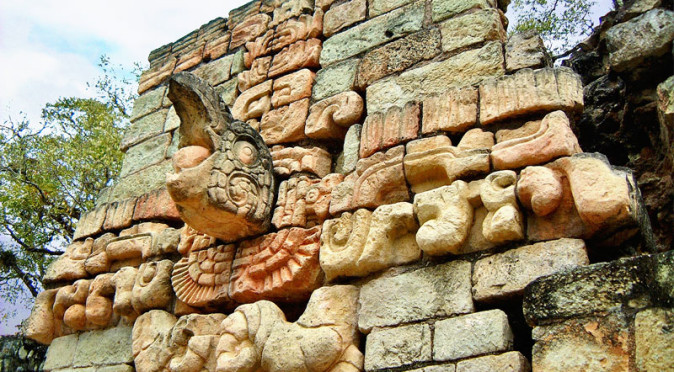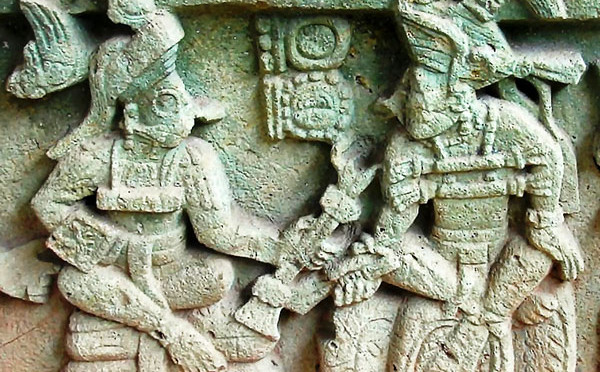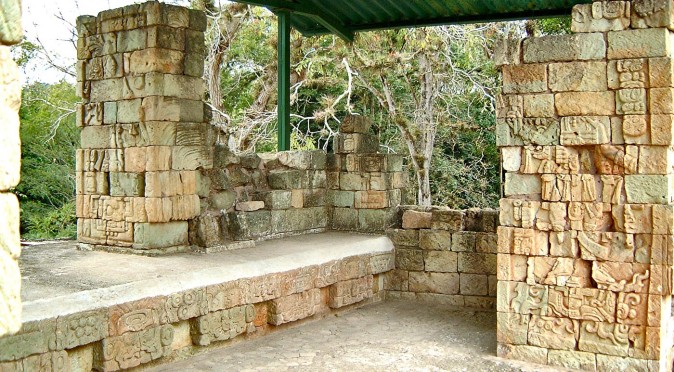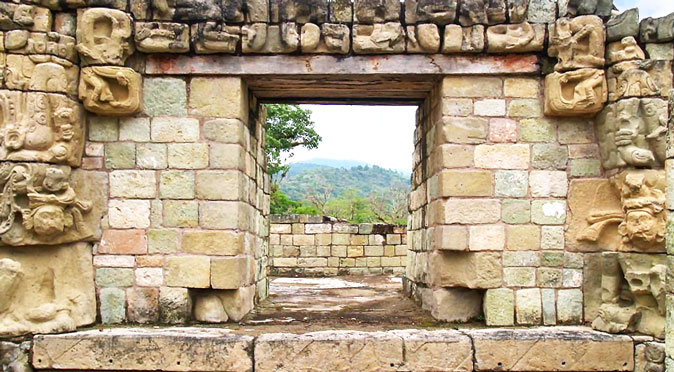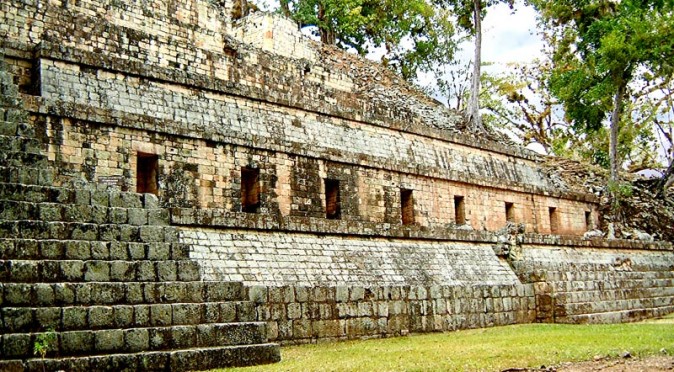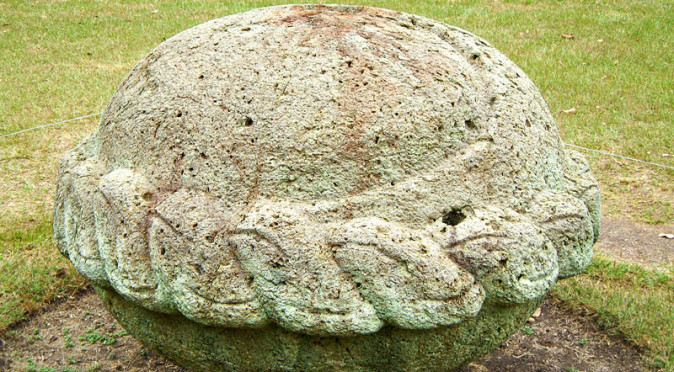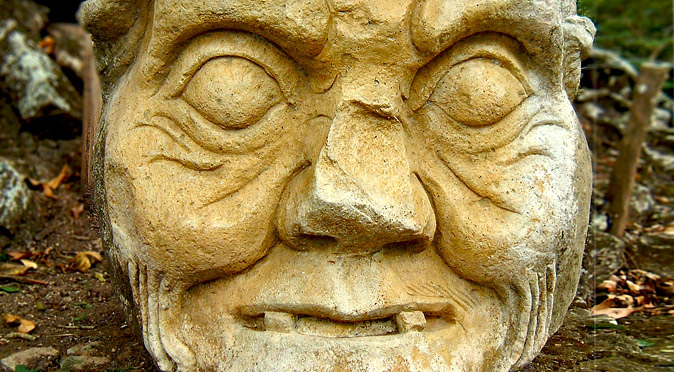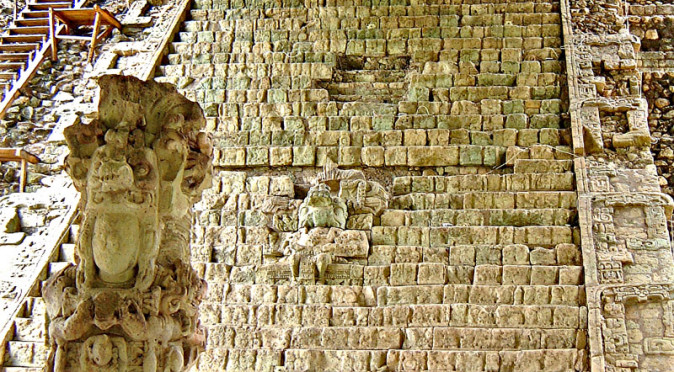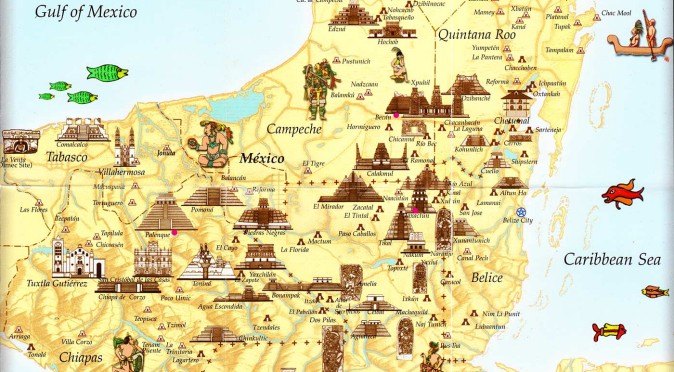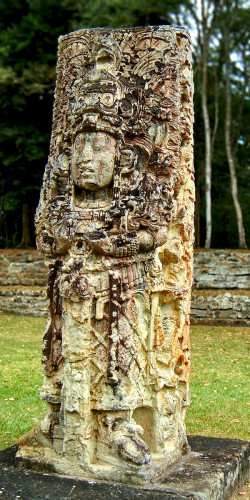
W1112: 18 Rabbit immortalised on Stela HThe Stelae at Copán are both magnificent and numerous. A stela is a single piece of stone that is carved or painted on at least one side with an inscription or an image. Stelae (plural) can be very basic; a simple example would be a large flat stone etched with a cross to make a gravestone. At Copan, however, stelae began to be used as a stone canvas for religious expression and the artwork became incredibly complex and sophisticated. The evolution from stone monument to religious art moved rapidly in the 8th century during the long reign of Uaxaclajuun Ub’aah K’awiil, known familiarly as 18 Rabbit (see fig. W1112). He erected seven stelae, which dominate the Main Plaza at Copan and demonstrate the rapid change in philosophy as his stelae became increasingly packed with symbolism to portray the king as a god, surrounded by the supernatural powers that his divine lineage had been born with. To accommodate the additional symbolism, the style also evolved from the classic style with four discrete sides carved in bas-relief, to a new style which used high-relief with elements flowing around the whole monument – leading to the term “wraparound” or “in-the-round”. The purpose of the monuments also shifted, with early stelea being used simply as memorials to record important events such as the death or accession of the king, whereas the later stelae were produced every 5 years, as part of the k’atun period festivals and became an integral part of re-enacting a religious event, such as the creation myth or the rebirth of the Maize God, but with the ruler visibly playing the role of God. These festivals also required a sacrificial altar and so many of the stelae are accompanied by an equally symbolic altar. These also developed into flamboyant pieces of religious art, often portraying the monstrous earth deities that needed to be fed. Lastly, these stone monuments weren’t just effigies of rulers and gods, they were the embodiment of all that was carved upon them. They were intended to capture the spirits and powers of the gods, immortalise their rulers, and to protect the city forever. For this reason, when ancestors failed and the city fell into decline, many of the monuments were defaced by breaking the nose off, as this was thought to kill them.
There are over 80 stelae at Copán, which is too much to cover in detail. So below is a selection that are found around the Main Plaza, in chronological order:
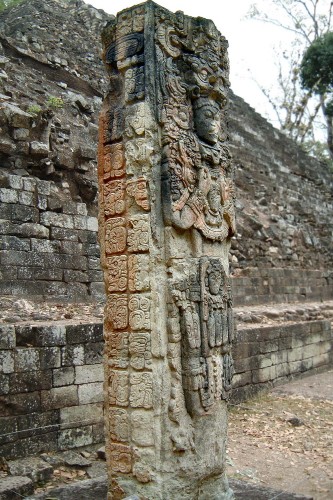
W1067: Stela PStela P
Stela P stands in front of Temple 16 and was dedicated with a Long Count date of 9.9.10.0.0, 2 Ajaw 13 Pop, which equates to the 21st March 623AD and makes it one of the oldest stelae you will see on site. Stela P is made in a typically classic style with all four sides being distinctly separate. The image of Butz Chan, the 11th Ruler of Copan, is carved in the familiar bas-relief style, but the face is carved in mid-relief, which would have been quite advanced. On the front, Butz’ Chan can be seen holding the double-headed serpent bar of divine kingship with his head locked in the jaws of the mountain God – two themes that would be present on almost every stelae that followed at Copán. The incredibly detailed and ornate bas-relief glyphs on the left-hand side (fig W1067) and the mid-relief face demonstrate these craftsmen had the skills to produce the elaborate symbolic embellishments seen on the later stelae, which tells us that the focus at this stage was to create a monolithic document and not a religious statement.
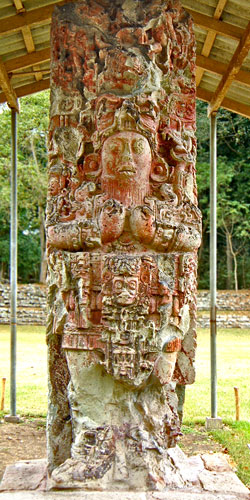
W1121: Stela C (West)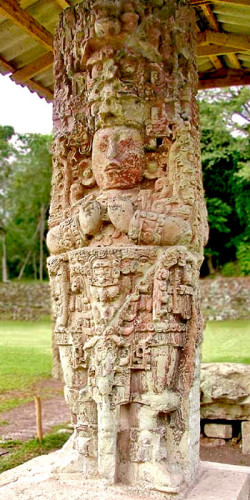
W1121F: Stela C (East)Stela C
Stela C was commissioned by Uaxaclajuun Ub’aah K’awiil (18-Rabbit) and is inscribed with a Long Count date of 9.14.0.0.0 – the 5th December, 711AD. The long count date tells us it was erected to record the ending of the 13th K’atun (a period of almost 20 years). This event coincided with a notable cosmic event, which may have prompted 18 Rabbit to commemorate it in such style and kick-start a trend of building stelae to celebrate K’atun events. Stela B pictures 18 Rabbit on both sides: the east face pictures him looking young; the west face pictures him with a beard, which signifies he is old.
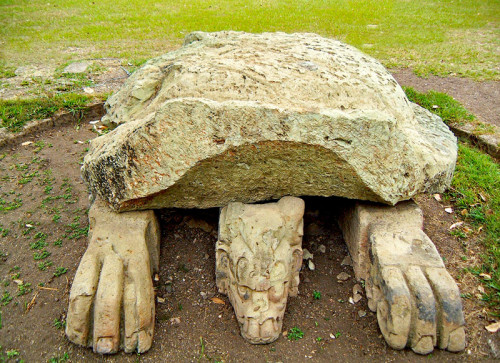
W1120: Altar CThe magnificent Stela B is paired with a rather rudimentary turtle altar. The turtle also features an aged skeletal face on one side and a young fleshed face on the other side. The combination of life and death, God and Turtle, combine to retell the Creation Myth in which the sons of the Maize God, Yax B‘ahlam and Ju‘n Ajaw, broke the shell of the Earth-Turtle to allow the Maize God to be reborn after being beheaded by the lords of Xibalba following his defeat in a ball game. By looking across the Altar at Stela C, we are given the impression that 18 Rabbit is the Maize God, being reborn from the turtle.

W1121SB: Serpent BarThe story begins on the eastern face of Stela C (fig. W1121F), with 18-Rabbit looking to the eastern horizon where the sun is reborn each day. Here, he is shown as a youthful king and holds the serpent bar of kingship in his hands (fig. W1121SB). From his waist hangs the head of a crocodile who represents the darkened section of the Milky Way – and is also found on the entrance to Temple 22. From these simple artistic devices, it becomes clear that we are not just being told a story, but that the statues are also describing a cosmic event.
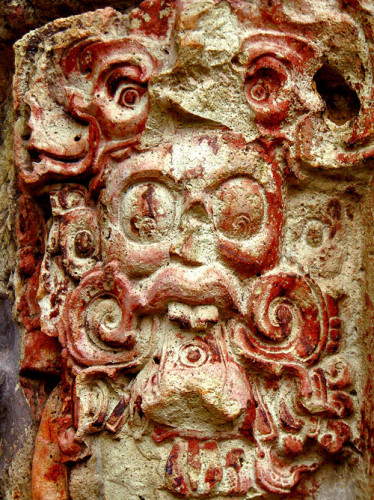
W1122: Severed headOn the western face of Stela A (fig. W1121), 18 Rabbit is represented as old man with a beard – which thought to be a fake ceremonial appendage as the Maya were unable to grow thick beards. On his apron, he has the face of a Jaguar God who is often associated with Venus and its interplay with the Sun. Beneath 18 Rabbit’s elbows, hangs the severed head of fanged deity, thought to be representative of the Maize God having been beheaded in the ball-game (you can see the limp tongue hanging forth and the scrolls of blood spurting from the neck in fig. W1122). So not only do we have a monumental account of the story of creation, with 18 Rabbit in the role of the Maize God, but we also have a celestial re-enactment taking place overhead. The imagery of 18-Rabbit describes the rising of the of Venus as the Evening Star and the turtle altar is also representative of the three stars of Orions belt, which travelled directly over Copan during the k’atun ending ceremony.
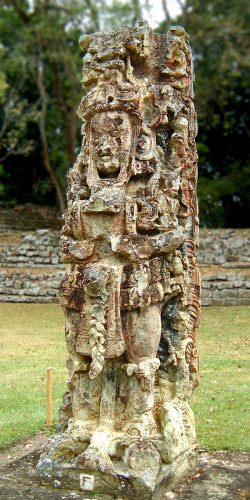
W1115: Stela FStela F
Stela F was commissioned by Uaxaclajuun Ub’aah K’awiil (18 Rabbit) and is dedicated with a date of 9.14.10.0.0 5 Ahaw 3 Mak – the 7th October 721AD. Again, 18 Rabbit holds the serpent bar, but here two gods associated with the Evening Star emerge from the serpents’ mouths. Stela F portrays 18-Rabbit as a mighty ball-game player and warrior, both of which are conceivably metaphors for sacrifice. His thighs are carved expertly in full relief to detail their muscular form. He wears the weighty belt and high protective boots of the ball player to complete the outfit. From his waist, a rope dangles down and ties his knees, terminating at his feet where it transforms into serpents mouths. The serpents have deities coming forth from their mouths, who come in honour of the sacrificial blood that spills down the rope – as the rope is thorned and pierces his penis to draw blood as part of his sacrificial duties. The ball-game is known to have been used as a substitute for war, with political conflicts being decided on the ball-court. The lack of evidence for war or conflict at Copan may be because the ball-court, rebuilt by 18 Rabbit twice, was used to decide regional conflicts – this may indeed have been why 18 Rabbit himself came to be beheaded, seemingly without fuss or retribution.

W1112: Stela H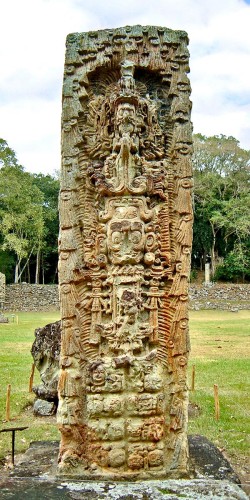
W1114: Back of Stela HStela H
Stela H is another of Uaxaclajuun Ub’aah K’awiil’s masterpieces and is dated with a Long Count of 9.14.19.5.0, or the 5th December 730AD. This unusual date is thought to have been chosen because the star pattern matched that witnessed at the K’atun ending ceremony of 9.14.0.0.0 when Stela C and its Altar were erected to tell the story of the death and rebirth of the Maize God. Stela H elaborates on this story and on the back of the monument you can see a highly decorative “backrack” – an archaic Mayan carrying device formed by inserting two sticks into the rear of a thick padded belt – on which 18 Rabbit carries one of the animals that will become one of the three Throne Stones of Creation (a story described in full at Quirigua through Stelae A and C and Zoomorph B – click here to read more…). The Maize Gods were responsible for carrying the animals on their backs’ in the creation myth, and so Stela H is another example of 18 Rabbit emulating the Maize God and reliving the events of the Creation. The backrack also represents the sacred tree which the Maize God planted at the centre of the hearth that he formed by planting the three stones.
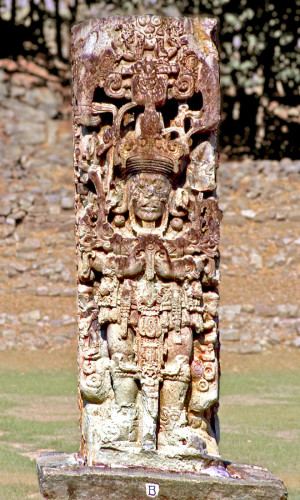
W1121B: Stela B (eastern face)Stela B
Stela B is renowned for featuring the heads of two elephants on the two top corners of the eastern face – where 18 Rabbit is also depicted wearing a turban, a Chinese style hat and a beard (see the article, The Elephants of Copan). Stela B was commissioned by Uaxaclajuun Ub’aah K’awiil (18 Rabbit) and is dedicated with a Long Count date of 9.15.0.0.0 4 Ahau 13 Yax, which equates to the 22nd August, 731AD. On it’s eastern side (fig. W1121B) the king is shown in holding the serpent bar of divine kingship and his head emerges from the jaws of the Macaw Mountain Monster (mo’ witz ). He wears crown made from cut shell and a fake beard, also thought to be made from shell. Around the periphery of the monument, branches extend upwards to symbolise the tree of life and also the maize plant. From these branches the heads of the first humans are seen growing. On the back, a giant face of the Mo Witz can be seen, thus emphasising that the elephants are actually the jaws of the Mo’ Witz. Stela B is is designed to demonstrate that 18 Rabbit has invoked the power of Chac and can renew the cosmos and provide continued fertility.
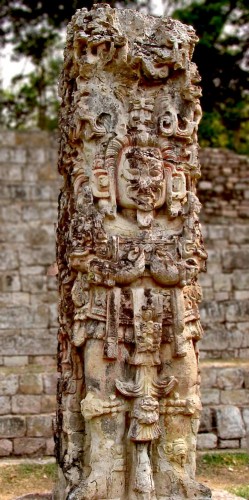
W1118F: Stela D (Front)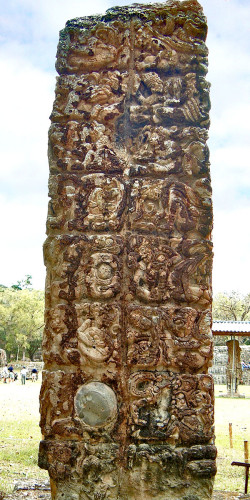
W1118B: Stela D (Back) Stela D
Stela D was dedicated with a Long Count date of 9.15.5.0.0 10 Ahau 8 Chen, which translates to 26th July 736AD. This makes it the last monument erected by 18 Rabbit before he was captured and beheaded by Cauac Sky of Quirigua. The front of Stela D shows 18 Rabbit holding the serpent sceptre, with the swept back hair of the Maize God, a wrinkled old face and a beard. On Stela D, the artistic format is further developed, with the front and sides now becoming a single image. The glyphs are moved to the back, which afforded the sculptors more room and allowed them to use a more elaborate style of full image writing.
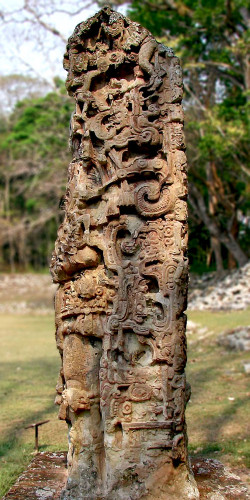
W1118S: Stela D (Side)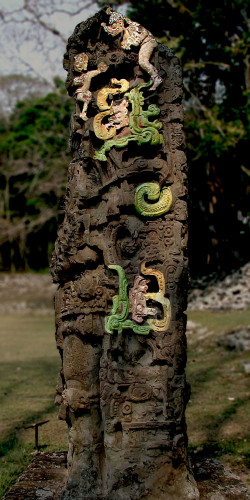
W1118S: Stela D (Side Coloured)Not only are the sides now part of the main image, but they also tell the greater part of the story. Each side features a double-headed serpent with the snake snouted God K appearing from each of their mouths. As is normal, fire emanates from God K’s head, which is thought to symbolise his role as the God of Lightning. However, the lightning appears to have grains of corn inside, and the curling flames look more like the leaves of a corn plant. At the top of the eastern side (fig. W1118SC) you can see God K passing instructions down to an ancestor. The scenes of both sides are thought to detail the vision ceremony, through which 18 Rabbit can communicate with God K and his ancestors to gain divine power.
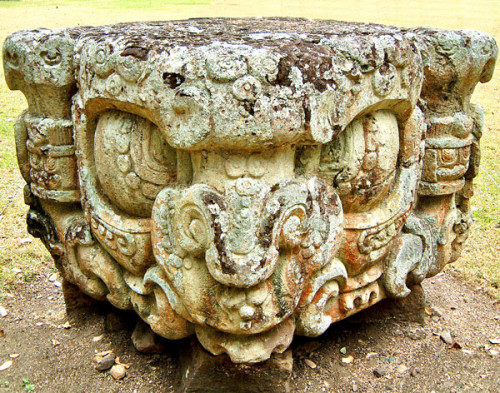
W1116: Altar D – Living Serpent 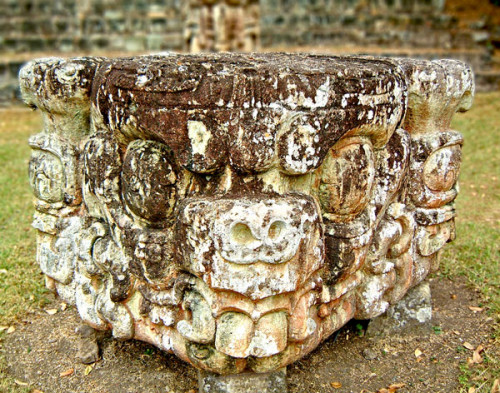
W1117: Altar D – Dead SerpeThe Altar to Stela D features the bicephalic (two-headed) serpent, with one side fleshed (fig. W1116) and the other side defleshed and skeletal (fig. W1117). This demonstrates the belief that the double-headed serpent-monster was both of the living world and the underworld.
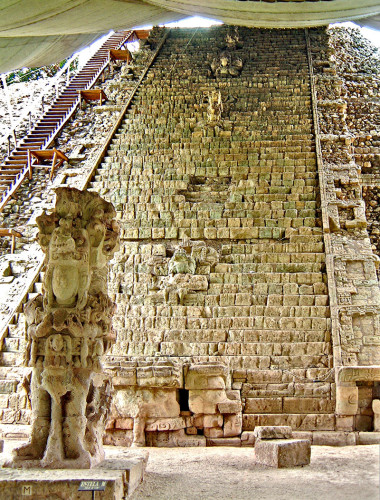
Hieroglyphic Stairway Stela M
Stela M portrays the 15th ruler, K’ak’ Yipyaj Chan K’awil (Smoke Shell), and was dedicated with a long count date of 9.16.5.0.0 8 Ahaw 8 Sotz’ – the 6th April 756AD. Stela M is situated at the foot of Temple 26, which Smoke Shell was responsible for rebuilding into its present form – this included lengthening the Hieroglyphic Stairway that was built by his grandfather, 18 Rabbit. Like the portrayal of 18 Rabbit on Stela F, Stela M features Smoke Shell dressed in ball-game attire in high-relief. Because the ball-game attire is also the sacred uniform of the warrior, repeated use of this costume on the latter stelae of Copán may suggest Copan’s rulers were increasingly turning to warfare to keep the city financed. Upon completion, Stela M would have probably been the finest stelae carved, but sadly, it has been badly eroded by weather.
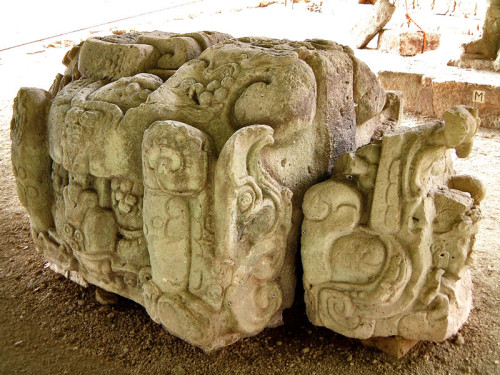
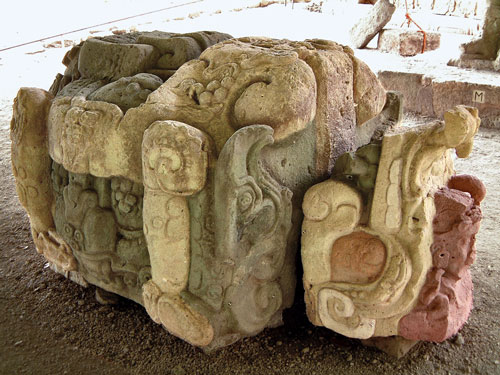
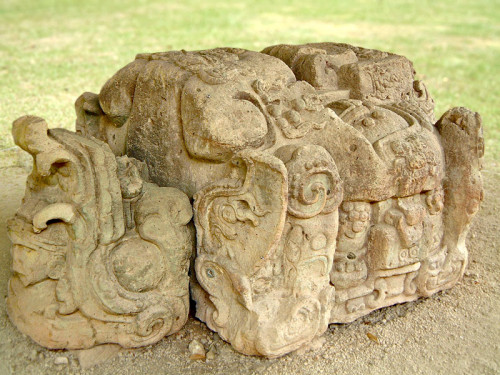
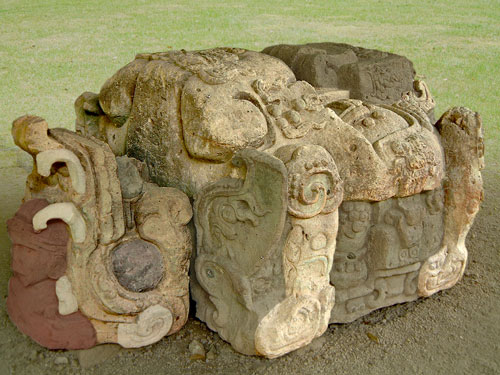 The Zoomorphic Altar to Stela M with its features highlighted
The Zoomorphic Altar to Stela M with its features highlighted
The Altars at Copan had been getting evermore complicated. With the Altar to Stela M, though, this complexity evolved into a new form of sculpture called zoomorpho. Quirigua is famous for its zoomorphic altars (click here to read more), and Altar M is clearly a precursor to that artistic development. Altar M features the head of a snake monster, the back of a turtle, and the legs of a jaguar. It also features the king being born from its monster’s mouth and the face of Chac is cleverly set into the beast’s undercarriage and also the beast’s back looking up.
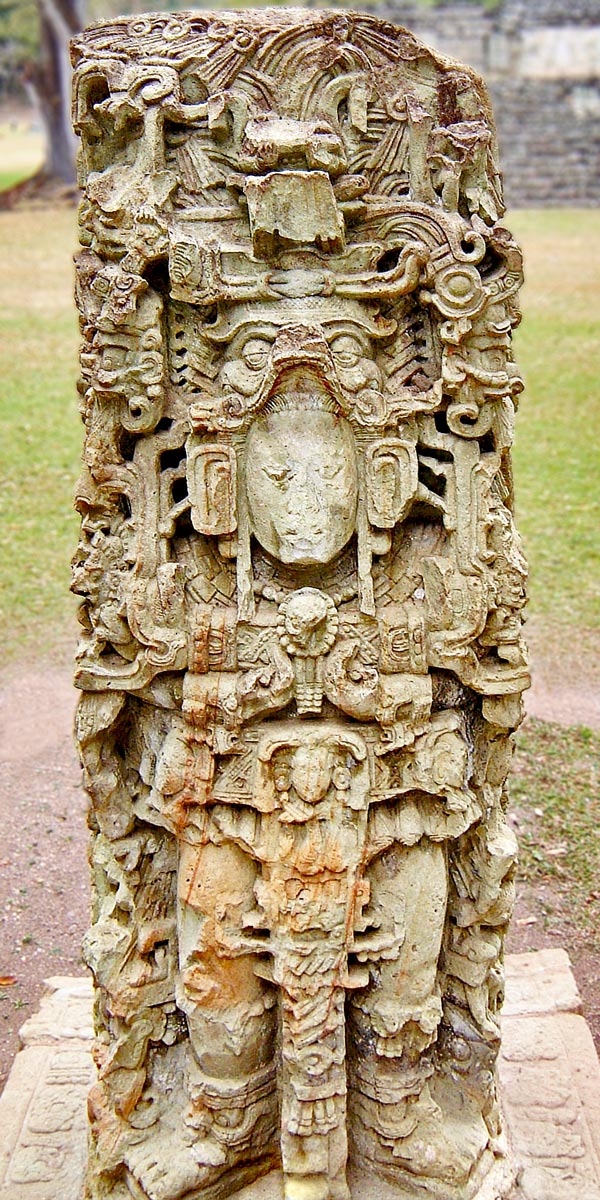
W1104: Stela N (South)
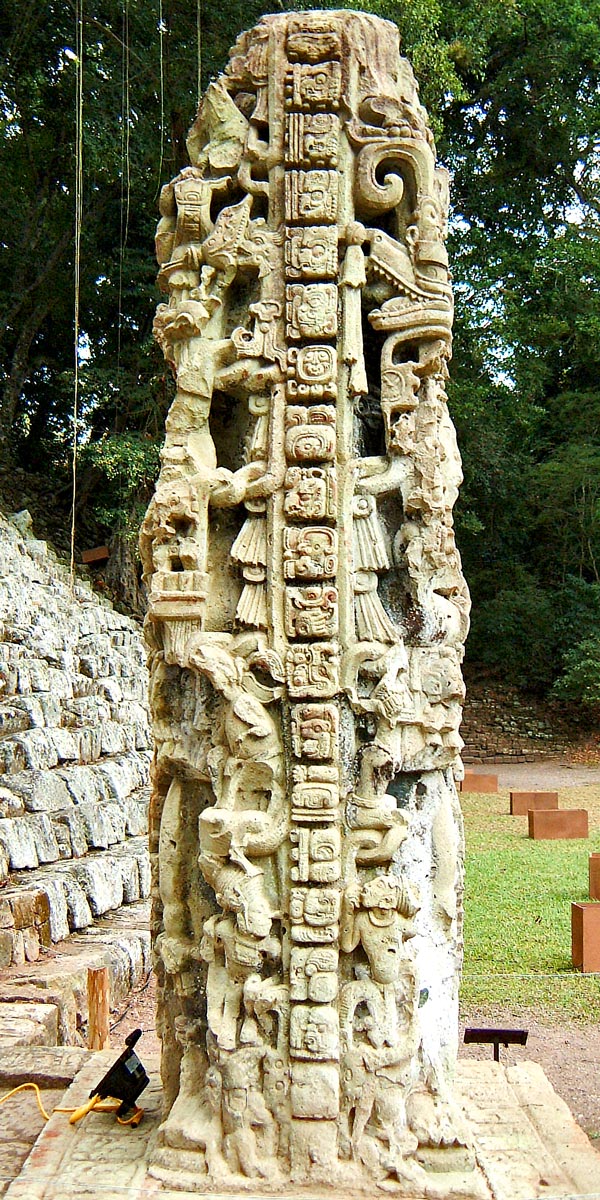
W1105: Stela N (East)Stela N
Stela N was built by the 15th Ruler, Smoke Shell, and was dedicated with a Long Count date of 9.16.10.0.0 1 Ahau 3 Sip – or the 17th March 761AD. Stela N is located at the foot of the stairs leading from the Main Plaza up to the East Court and north side of Temple 11 – it is thought that Smoke Shell may be buried beneath the structure. Stela N is another fantastic demonstration of the development of new artistic ideas. The front and rear of the monument feature the king in full-relief, with the symbols of his divine power wrapping around to the sides. To accommodate additional art around the sides and increase the three-dimensional effect, the glyphs have been reduced to a single column each side and made to look as though they are part of the backrack (figs W1104 & W1105).
The two single strips of glyphs that run down either side can be almost entirely deciphered. On the east side (fig. W1105) reading from the top, it says:
[1] of the year [2] 9.. [3] 16 Winikhaab’ [4] 10 Haab’ [5] 0 Winik [6] 0 K’in [7] 1 Ahaw [8] ? [9] The edge of the book [10] ?? God [11] It was the first tying [12] Mihil K‘uh Chapaaht [13] it was the sprout name of [14] 30 days [15] 3 Chakat [16] it was planted into the ground [17] ??-Pas [18] Haa’l [19] ?? [20] ??-aj 1
The text continues on the west side, with the combined text translating as: “The count of the year was 9 Baktuns 16 Katuns 10 Tuns 0 Uinal 0 Kin on 1 Ahau [when]…was the speaker of the book [when] it was the first…-tying [and] Mihil K‘uh Chapaaht was the sprout name of 30 [days] lunar month on 3 Sip it was planted into the ground…Pas Ha‘l…[the banner stone of] K‘ahk‘ Nik Te‘ Wi‘…Nah Kan…Chiit K’uh K‘ahk‘ Yipyaj Chan K‘awiil Sacred Copan Lord [then] it was the count of 0 kin 0 uinal 10 tuns 14 katuns 17 baktuns 14 kalabtuns [and] it happened on 1 Ahau 8 Chen the stone-wrapping [by] the Resplandent Ajan…” 1
The text and imagery relate to the binding of the stones by the Maize God at the beginning time. On the side of Stela N (fig. W1105) you can see two small human figures sprouting from behind his knees who wear turbans identical to that worn by 18 Rabbit on Stela B. They represent Smoke Shell’s ancestors being born, like ears of corn, at the beginning of time. Above them, you can see anthropomorphic beings and animals emerging from the branches of this tangled tree of life. On the front (fig. W1104), the serpent bar he holds across his chest clearly features God K being born from the serpents’ mouths. The combined images tell us that Smoke Shell is a descendant of the royal lineage of Copan and takes the role of the Maize God by planting this stone (stela) at the beginning of time (now).
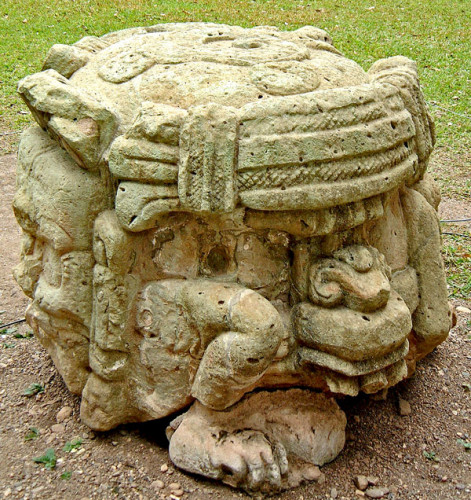
W1103: Altar NThe altar to Stela N continues the zoomorphic theme that began with Altar M, five years earlier. Altar N is far more curious though, as it has no real body and features four faces. This perhaps indicates that is designed to reflect the cardinal points and is a curious interpretation of the four Pauahtun, or B’akab, who hold up the four corners of the universe. Certainly the top appears to represent the net hat that Pauahtun wears (see fig. W1103), but two of the faces feature the snarling nose of the serpent monster that is so often seen at Copan. The other two sides feature the skeletal image of the mountain-monster (witz-monster). The clawed limb seen in fig. W1103 is totally out of place, as there is no second limb – the other side features two hands resting under the chin. Interestingly, the glyph on top suggests that this is not an altar at all and is actually Smoke Shell’s throne.
References:
1 – http://www.famsi.org/research/copan/monuments/CopanMonumentManualPart6.pdf

